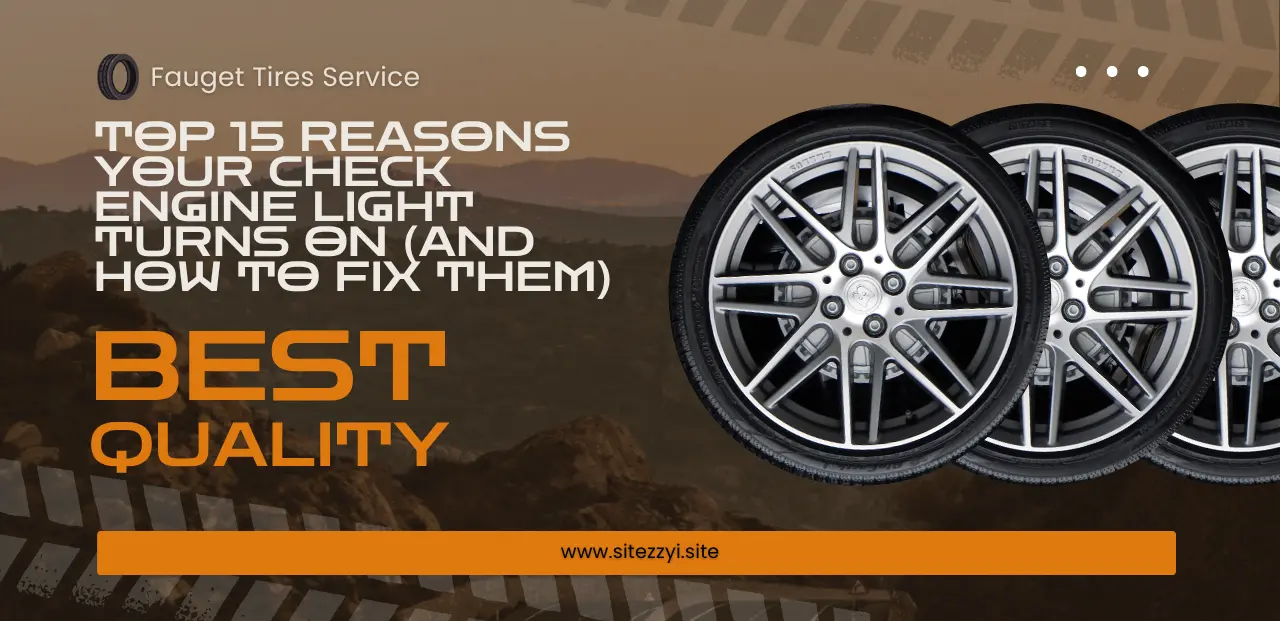The check engine light (CEL) is one of the most dreaded warnings on your dashboard. It can indicate anything from a minor issue to a serious engine problem. Ignoring it can lead to costly repairs or even engine failure.
In this guide, we’ll explore the top 15 reasons why your check engine light comes on and provide practical solutions to fix them. Whether you’re a car enthusiast or a daily driver, this information will help you diagnose and resolve common engine problems.
Also Check: Understanding Car Battery Replacement Costs: A Complete Guide
1. Loose or Faulty Gas Cap
A loose, damaged, or missing gas cap is one of the most common reasons for the check engine light. It causes fuel vapors to leak, reducing fuel efficiency.
✅ Fix: Tighten or replace the gas cap. If the light stays on, reset it by disconnecting the battery for a few minutes.
2. Faulty Oxygen (O2) Sensor
The O2 sensor monitors unburned oxygen in the exhaust. A failing sensor can reduce fuel efficiency and increase emissions.
✅ Fix: Replace the faulty O2 sensor (usually located near the exhaust manifold or catalytic converter).
3. Catalytic Converter Failure
A failing catalytic converter can trigger the CEL due to clogging or damage, leading to poor performance and increased emissions.
✅ Fix: Replace the catalytic converter if it’s clogged or damaged. Regular maintenance can prevent this issue.
4. Bad Spark Plugs or Ignition Coils
Worn-out spark plugs or ignition coils cause misfires, reducing engine power and fuel economy.
✅ Fix: Replace spark plugs every 30,000–100,000 miles (depending on type) and faulty ignition coils.
5. Mass Airflow (MAF) Sensor Malfunction
The MAF sensor measures air entering the engine. A dirty or faulty sensor can cause rough idling and poor acceleration.
✅ Fix: Clean the MAF sensor with a specialized cleaner or replace it if damaged.
6. Exhaust Gas Recirculation (EGR) Valve Issues
A clogged or stuck EGR valve can increase emissions and cause engine knocking.
✅ Fix: Clean or replace the EGR valve to restore proper function.
7. Faulty Thermostat
A stuck-open or stuck-closed thermostat affects engine temperature, triggering the CEL.
✅ Fix: Replace the thermostat to ensure proper engine cooling.
8. Dead or Weak Battery
A failing battery or alternator can cause voltage fluctuations, leading to a CEL.
✅ Fix: Test the battery and alternator. Replace if necessary.
9. Evaporative Emission Control System (EVAP) Leak
A leak in the EVAP system (often due to a cracked hose or faulty purge valve) can trigger the CEL.
✅ Fix: Inspect hoses and valves. Replace damaged components.
10. Faulty Fuel Injectors
Clogged or leaking fuel injectors can cause misfires and poor fuel economy.
✅ Fix: Clean or replace fuel injectors.
11. Transmission Problems
A failing transmission control module (TCM) or solenoid can trigger the CEL.
✅ Fix: Get a professional diagnostic scan and repair.
12. Low Engine Oil or Oil Pressure Issues
Low oil levels or faulty oil pressure sensors can illuminate the CEL.
✅ Fix: Check oil levels and top up. Replace the sensor if faulty.
13. Worn-Out Timing Belt
A slipping or broken timing belt can cause severe engine damage and trigger the CEL.
✅ Fix: Replace the timing belt as per manufacturer recommendations.
14. Faulty Throttle Position Sensor (TPS)
A malfunctioning TPS affects acceleration and fuel efficiency.
✅ Fix: Replace the throttle position sensor.
15. Engine Misfire
A misfiring engine (due to bad spark plugs, fuel injectors, or compression issues) will trigger the CEL.
✅ Fix: Diagnose the cause (spark plugs, coils, fuel system) and repair.
FAQs About Check Engine Light
1. Can I drive with the check engine light on?
It depends. A solid light may indicate a minor issue, but a flashing light means a serious problem—stop driving immediately.
2. How do I reset the check engine light?
You can reset it by:
Disconnecting the battery for 10 minutes
Using an OBD-II scanner to clear codes
3. Will the check engine light turn off by itself?
Sometimes, if the issue resolves (e.g., tightening the gas cap). Otherwise, it needs manual resetting.
4. How much does it cost to fix a check engine light?
Costs vary:
Gas cap replacement: $10–$50
O2 sensor replacement: $100–$300
Catalytic converter replacement: $500–$2,000
Final Thoughts
The check engine light is a crucial warning system. While some fixes are simple (like tightening a gas cap), others require professional help. Regular maintenance can prevent many of these issues.
If your CEL stays on, use an OBD-II scanner to diagnose the problem or visit a mechanic for a thorough inspection.
Did you find this guide helpful? Share it with fellow drivers to help them stay informed!

Pingback: Car Shaking While Driving? Top 10 Causes and How to Fix Them - sitezzyi.site